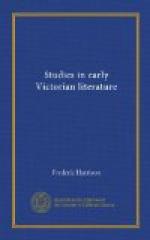wrote of his friend:—“I am grateful
for the innocent laughter and the sweet and unsullied
page which the author of
David Copperfield
gives to my children.” We need not formulate
any dogma or rule on such a topic, nor is it essential
that all books should be written
virginibus puerisque;
but it is certain that every word of Charles Dickens
was so written, even when he set himself (as he sometimes
did) to describe animal natures and the vilest of their
sex. Dickens is a realist in that he probes the
gloomiest recesses and faces the most disheartening
problems of life: he is an idealist in that he
never presents us the common or the vile with mere
commonplace or repulsiveness, and without some ray
of humane and genial charm to which ordinary eyes
are blind. Dickens, then, was above all things
a humourist, an inexhaustible humourist, to whom the
humblest forms of daily life wore a certain sunny
air of genial mirth; but the question remains if he
was a humourist of the highest order: was he a
poet, a creator of abiding imaginative types?
Old Johnson’s definition of humour as “grotesque
imagery,” and “grotesque” as meaning
some distortion in figure, may not be adequate as
a description of humour, but it well describes the
essential feature of Charles Dickens. His infallible
instrument is caricature—which strictly
means an “overload,” as Johnson says,
“an exaggerated resemblance.” Caricature
is a likeness having some comical exaggeration or distortion.
Now, caricature is a legitimate and potent instrument
of humour, which great masters have used with consummate
effect. Leonardo da Vinci, Michael Angelo, Rembrandt,
Hogarth, use it; but only at times, and in a subsidiary
way. Rabelais, Swift, Fielding, use this weapon
not unfrequently; Shakespeare very sparingly; Goldsmith
and Scott, I think, almost never. Caricature,
the essence of which is exaggeration of some selected
feature, distortion of figure, disproportion of some
part, is a potent resource, but one to which the greater
masters resort rarely and with much moderation.
Now with Charles Dickens caricature—that
comical exaggeration of a particular feature, distortion
of some part beyond nature—is not only
the essence of his humour, but it is the universal
and ever-present source of his mirth. It would
not be true to say that, exaggeration is the sole
form of humour that he uses, but there is hardly a
character of his to which it is not applied, nor a
scene of which it is not the pervading “motive.”
Some feature, some oddity, some temperament is seized,
dwelt upon, played with, and turned inside out, with
incessant repetition and unwearied energy. Every
character, except the walking gentleman and the walking
lady, the insipid lover, or the colourless friend,
have some feature thrust out of proportion, magnified
beyond nature. Sam Weller never speaks without
his anecdote, Uriah is always “’umble,”
Barkis is always “willin’,” Mark
Tapley is always “jolly,” Dombey is always




